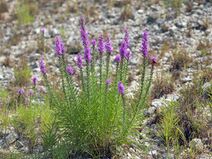Liatris punctata
| Liatris punctata | |
 | |
| Light: | |
| Moisture: | |
| Hardiness: | 3 |
| Soil pH: | 5.6-8.4 |
| Height: | 2' |
| Blooms: | Late Summer-Early Fall |
| Open Woods Forest | |
| Native to: | |
| Shelter Nectary | |
| Edible Rating: | |
| Medicinal Rating: | |
| Tea: | Yes |
Liatris punctata (common name: snakeroot)
Propagation: Seed - best sown as soon as it is ripe in autumn in a greenhouse[1]. Sow stored seed as soon as possible in the year in a greenhouse. Prick out the seedlings into individual pots when they are large enough to handle and grow the plants on in the greenhouse for their first year. Plant them out into their permanent positions in early summer.
Division in spring[2]. Larger clumps can be replanted direct into their permanent positions, though it is best to pot up smaller clumps and grow them on in a cold frame until they are rooting well. Plant them out in the spring.
Basal cuttings taken in spring as growth commences. Harvest the shoots when they are about 10cm long with plenty of underground stem. Pot them up into individual pots and keep them in light shade in a cold frame or greenhouse until they are rooting well. Plant them out in the summer.
Cultivation: Grows well in a moderately good light soil[1].Tolerates poor soils[1]. Plants are prone to rot overwinter in wet soils[1].
A good bee plant.
Rodents are very fond of the tubers so the plants may require some protection[1].
Range: Eastern N. America - Alberta to New Mexico and Texas, east to Minnesota and Nebraska..
Habitat: Dry prairies and plains[3].
Edibility: Root - raw or cooked[4][5][6][7][8][9]. A sweet flavour when harvested in the spring and baked[9]. Eating the root is said to improve the appetite[9].
Medicinal: An infusion of the roots has been used in the treatment of stomach aches, bloody urine and women's bladder complaints[9]. The root has been chewed and the juice swallowed in the treatment of swollen testes[9]. A decoction of the roots is used as a wash for itching skin complaints[10][9]. A poultice of the boiled roots is applied to swellings[9].
Pollinators: Bees
Soil: Can grow in light and medium soils.
Drainage: Prefers well drained soil.
Seed Ripens: Mid Fall
Flower Type: Hermaphrodite
Also Known As: Laciniaria punctata. (Hook.)Kuntze.
Links
References
- ↑ 1.0 1.1 1.2 1.3 1.4 Huxley, Anthony. The New Royal Horticultural Society Dictionary of Gardening. MacMillan Press, 1992.
- ↑ Chittendon, Fred. RHS Dictionary of Plants. Oxford University Press, 1951.
- ↑ Lyndon, Merritt. Gray's Manual of Botany. American Book Co, 1950.
- ↑ Uphof, Johannes. Dictionary of Economic Plants. Weinheim, 1959.
- ↑ Usher, George. A Dictionary of Plants Used by Man. Constable, 1974.
- ↑ Tanaka, Tyōzaburō. Tanaka's Cyclopaedia of Edible Plants of the World. Keigaku Publishing, 1976.
- ↑ Yanovsky, Elias. Food Plants of the North American Indians Publication 237. US Department of Agriculture.
- ↑ Davis, Ray and Frank Craighead. A Field Guide to Rocky Mountain Wildflowers. The Riverside Press, 1963.
- ↑ 9.0 9.1 9.2 9.3 9.4 9.5 9.6 Moerman, Daniel. Native American Ethnobotany. Timber Press, 1998.
- ↑ Bown, Deni. Royal Horticultural Society Encyclopaedia of Herbs and Their Uses. Dorling Kindersley, 1995.